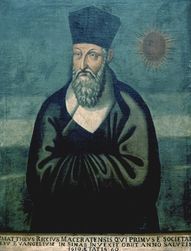1601
| Millennium: | 2nd millennium |
|---|---|
| Centuries: | 16th century – 17th century – 18th century |
| Decades: | 1570s 1580s 1590s – 1600s – 1610s 1620s 1630s |
| Years: | 1598 1599 1600 – 1601 – 1602 1603 1604 |
| 1601 in topic: |
| Subjects: Archaeology – Architecture – |
| Art – Literature – Music – Science |
| Leaders: State leaders – Colonial governors |
| Category: Establishments – Disestablishments |
| Births – Deaths – Works |
- For the Mark Twain work, see 1601 (Mark Twain).
Year 1601 (MDCI) was a common year starting on Monday (link will display the full calendar) of the Gregorian calendar (or a common year starting on Thursday (Julian-1601) of the 10-day slower Julian calendar).
Contents |
Events of 1601

January–June
- January 1 – The first day of the seventeenth century.
- February 8 – Robert Devereux, 2nd Earl of Essex, longtime favorite of Queen Elizabeth I, rebels against the queen; his revolt is quickly crushed.
- February 25 – Robert Devereux is beheaded.
July–December
- 24 December (Julian Calendar) – The Battle of Kinsale ends the siege of Kinsale, Ireland, a siege that started in the autumn of 1601. According to the Gregorian Calendar used by the Irish and Spanish forces in the battle, its date was 3 January 1602.
Undated
- The Jesuit Matteo Ricci becomes the first European to enter the Forbidden City in Beijing, China, during the Ming Dynasty.
- A bad harvest occurs in Russia due to a rainy summer.
- Dutch troops drive the Portuguese from Málaga.
- A famine (-1603) kills about half the Estonian population.
Births
| Gregorian calendar | 1601 MDCI |
| Ab urbe condita | 2354 |
| Armenian calendar | 1050 ԹՎ ՌԾ |
| Bahá'í calendar | -243 – -242 |
| Bengali calendar | 1008 |
| Berber calendar | 2551 |
| Buddhist calendar | 2145 |
| Burmese calendar | 963 |
| Byzantine calendar | 7109 – 7110 |
| Chinese calendar | 庚子年十一月廿七日 (4237/4297-11-27) — to —
辛丑年十二月初八日(4238/4298-12-8) |
| Coptic calendar | 1317 – 1318 |
| Ethiopian calendar | 1593 – 1594 |
| Hebrew calendar | 5361 – 5362 |
| Hindu calendars | |
| - Bikram Samwat | 1657 – 1658 |
| - Shaka Samvat | 1523 – 1524 |
| - Kali Yuga | 4702 – 4703 |
| Holocene calendar | 11601 |
| Iranian calendar | 979 – 980 |
| Islamic calendar | 1009 – 1010 |
| Japanese calendar | Keichō 6 (慶長6年) |
| Korean calendar | 3934 |
| Thai solar calendar | 2144 |
- January 8 – Baltasar Gracián y Morales, Spanish prose writer (d. 1658)
- May – Spencer Compton, 2nd Earl of Northampton (d. 1643)
- May 2 – Athanasius Kircher, German Jesuit scholar (d. 1680)
- August 17 – Pierre de Fermat, French mathematician (d. 1665)
- August 22 – Georges de Scudéry, French novelist, dramatist and poet (d. 1667)
- September 13 – Jan Brueghel the Younger, Flemish painter (d. 1678)
- September 22 – Anna of Austria, queen of Louis XIII of France and regent (d. 1666)
- September 27 – King Louis XIII of France (d. 1643)
- date unknown
- probable
- See also Category:1601 births.
Deaths
- January 19 – Henry Herbert, 2nd Earl of Pembroke, English statesman (b. 1534)
- February 25 – Robert Devereux, 2nd Earl of Essex, English politician (b. 1566)
- February 27 – Anne Line, English saint (birthdate unknown)
- April 10 – Mark Alexander Boyd, Scottish poet and soldier of fortune (b. 1562)
- May 19 – Costanzo Porta, Italian composer (b. 1528)
- August 9 – Mihai Viteazul, Prince of Wallachia (b. 1558)
- October 24 – Tycho Brahe, Danish astronomer (b. 1546)
- date unknown
- probable
- Thomas North, English translator of Plutarch (b. 1535)
- John Shakespeare, English glover and farmer, father of William Shakespeare (b. 1529)
- See also Category:1601 deaths.
Notes
January 1, 1601, is used as the base of file dates[1] by Microsoft Windows.
January 1, 1601, is used as the base of Active Directory Logon dates[2] by Microsoft Windows.
ANSI dates are counted from 1601-01-01 and were adopted by the American National Standards Institute for use with COBOL and other computer languages. This epoch is the beginning of the last 400-year cycle by which leap-years are calculated in the Gregorian calendar. The last year of this cycle is the only one divisible by 100 that is a leap-year, which was the year 2000, and which was followed by a new 400-year cycle beginning with 2001. 32-bit versions of the Microsoft Windows operating system count units of one hundred nanoseconds from this epoch. http://www.decimaltime.hynes.net/dates.html
References
- ↑ Microsoft Windows technical note on file dates, referencing year 1601. http://support.microsoft.com/kb/188768
- ↑ Microsoft Windows technical note on file dates, referencing year 1601. http://www.microsoft.com/technet/scriptcenter/topics/win2003/lastlogon.mspx
